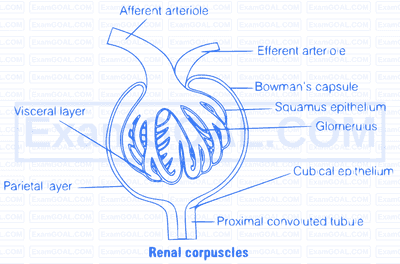Actively transported substances during reabsorption of GFR- Glucose, amino acids, $\mathrm{Na}^{+}$.
Passively transported substances during reabsorption of GFR- Nitrogenous wastes, water.
Complete the following
(a) Urinary excretion $=$ tubular reabsorption + tubular secretion -
(b) Dialysis fluid = plasma -
(a) Urinary excretion $=$ tubular reabsorption + tubular secretion - filtration
(b) Dialysis fluid = plasma - nitrogenous wastes.
The concentration gradient in medullary interstitium is established primarily by renal tubules of loop of Henle and the blood vessels surrounding them (vasa recta) in a process called countercurrent exchange.
The substances that exit from tubules for maintenance of such gradient are mainly sodium chloride $(\mathrm{NaCl})$, water and urea (contaning $\mathrm{H}^{+}, \mathrm{K}^{+}$and $\mathrm{NH}_3^{+}$).
Fill in the blanks appropriately
| Organ | Excretory wastes | |
|---|---|---|
| (a) | Kidneys | ...................... |
| (b) | Lungs | ..................... |
| (c) | Liver | .................... |
| (d) | Skin | .................... |
| Organ | Excretory wastes | |
|---|---|---|
| (a) | Kidneys | Urine |
| (b) | Lungs | CO$_2$ |
| (c) | Liver | Urea |
| (d) | Skin | Sweat |
Representing the structure of a renal corpuscle
